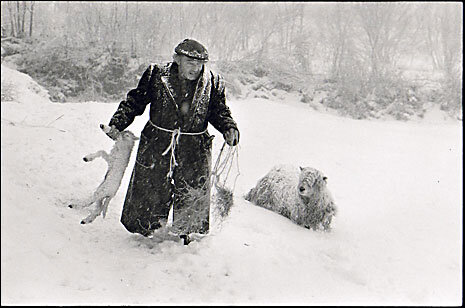Well, I’m in two minds. On the one hand, here we have some really beautiful photographs. On the other, there are about 80,000 of them. When does enough become too much?
James Ravilious moved to North Devon in 1972 and was given a commission by the local Arts Centre, now the Beaford Archive, to record in photographs the life of the local area. I had always been aware of him and his work through reading about his father, Eric Ravilious (see my September 2019 post about the latter below). Then I spotted this recent selection of 75 photographs ‘The Recent Past’ at a very reasonable price new. Fashion in photobooks is a funny thing: this one was published in 2017 with a cover price of £30 and now it is available new for about two-thirds of that. I’m a sucker for the old-fashioned, well-crafted, black and white documentary photograph but still - the book is worth every penny.
The dust jacket talks of photographs of a ‘vanishing or vanished’ way of life. I find that quite a tricky idea since ways of life are vanishing and new ones emerging every day and everywhere. It might be easier therefore to see this as a collection of images of local people who were alive in north Devon in the 1970s and 80s, of their work and social activities, and of the countryside they lived in. For me the outstanding quality of the photographs is their warmth and humanity. In her introduction to the book, James’ wife, Robin, says that he got on well with people and made friends easily and that seems to have given him an easygoing approach well-suited to the task he had undertaken.
Ivor Brock rescuing a lamb in a blizzard, February 1978.
Bill Hammond completing a rick of wheat straw for thatching, 1986.
That 80,000 image archive though: that’s another matter. When I started studying photographic history I thought an ‘archive’ was some sort of formal description of a well-ordered and catalogued photographic collection. I soon learned that it was no such thing and could often be little more than piles of boxes or filing cabinets whose contents were only dimly remembered even by those in charge of them. That may be true of all historical archives, but at least files and other written documents with titles would usually be listed at the very least in alphabetical order. Photographs have no such obvious device to rely on.
I imagine James Ravilious’ 80,000 images will be better ordered than most since he was creating them as a matter of record and The Beaford Archive was preserving them for that purpose, too. But in any photographic archive it still takes a formidable cataloguing system to enable a researcher to pull out all the prints on any given subject. If someone does write a history of the small part of North Devon that he was photographing then doubtless this archive will be invaluable. For just about everyone else I think the value of his work lies not so much in its depiction of a vanishing world as in the timeless and quiet beauty which emerges from such careful photography.
Percy and Alice Shaxton, No Place, Ebberley, 1975.



